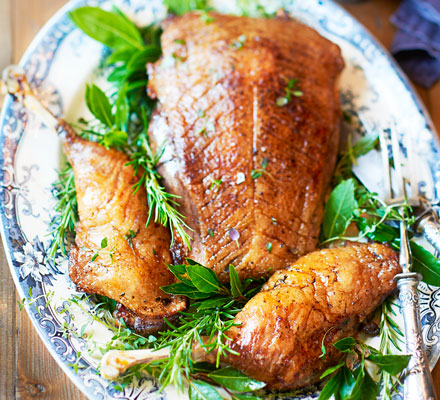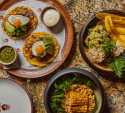Raymond’s roast goose
Raymond Blanc’s recipe for this classic Christmas bird yields perfectly tender leg and breast meat and crisp, golden skin
-
Prep:25 mins
Cook:2 hrs 30 mins
plus resting - Serves 10
- More effort
Nutrition per serving
-
kcal 697
-
fat 49g
-
saturates 17g
-
carbs 3g
-
sugars 0g
-
fibre 0g
-
protein 52g
-
salt 0.8g
Ingredients
- 4½ -5kg free-range organic goose, excess fat trimmed and discarded, legs removed; wings, neck and excess carcass removed and chopped into 2cm/¾ in pieces (about 600g/1lb 5oz)
- 2 bay leaves
- 5 thyme sprigs
- 1 garlic clove, sliced
- white pepper, for seasoning
- 2 tbsp goose fat
- 1 small onion, cut into 3cm/1¼in pieces
- 1 carrot, cut into 3cm/1¼in pieces
- 25g celery, cut into 3cm/1¼in pieces
- 85g unsalted butter, softened
- 200ml port
- 100ml Madeira
- ½ tsp arrowroot, if needed
- sprigs of fresh herbs such as bay, rosemary and thyme, to serve
Tip
Raymond's tipsIn my opinion, it is impossible to roast a whole goose and end up with the legs and breast cooked perfectly – by the time the legs are tender, the breast is overdone. My solution is to take the legs off and slow-cook them, then quick- roast the breast on top so it’s still nice and pink. Ask your butcher to prepare the goose for you and remove the wishbone – this makes it easier to carve.
Storing goose fatPour the reserved goose fat through a fine sieve into a sterilised jar. It will keep in the fridge for 2-3 months.
White pepperWhite pepper is used in classic French cooking – it has a hot, peppery kick and is favoured in white sauces as it doesn’t leave black specks, like black pepper.
Method
Take the goose out of the fridge 2 hrs before roasting. Heat oven to 150C/130C fan/gas 2. Chop 1 bay leaf and the leaves from 2 thyme sprigs together. Mix with the garlic, 1/2 tsp coarse sea salt and 2 pinches of white pepper, then rub into the flesh of the goose legs.
Heat the goose fat in a large flameproof roasting tin on a medium heat. Add the wings, neck and excess carcass and cook for 5 mins until lightly golden. Do not colour the bones too much, or the resulting jus will taste bitter. Add the onion, carrot and celery, and continue to brown for 3 mins.
Place the goose legs, skin-side up, in the roasting tin with the bones and vegetables. Cover the tin tightly with foil and roast for 1 hr.
Rub the goose crown with the butter and season well with sea salt and freshly ground white pepper. Remove the tin from the oven and increase the temperature to 230C/210C fan/gas 8. Remove the foil from the tin and sit the goose crown on top of the legs and bones, which will help the heat to circulate the crown, cooking it more evenly. Roast for 30 mins until the crown is golden.
Reduce oven to 150C/130C fan/gas 2. Add the remaining bay leaf, 3 thyme sprigs and 300ml hot water to the tin to lift the caramelised juices from the pan and the bones. (It will also keep the goose moist.) Continue to cook for 30-35 mins, basting every 10 mins with the juices, until a probe thermometer inserted into the breast reads 55C.
Remove the crown from the oven and wrap tightly in foil. Rest for 30 mins to allow the meat to become tender. Continue to cook the goose legs during this time. Meanwhile, heat the Port and Madeira in a small pan and simmer to reduce by half. Remove the goose legs from the oven, then place on a tray, wrap in foil and leave to rest in a warm place.
Pour off the excess fat from the roasting tin and reserve (see tip, below). Remove the bones and veg from the tin and place the tin on a medium heat. Bring to the boil and stir to lift the juices. Add the reduced alcohol. Taste and adjust the seasoning if required, then pour the resting juices which have collected under the goose into the jus. If the sauce is a little thin, mix the arrowroot with 1 tsp cold water, then add a little at a time to ensure that it does not become too thick. Sieve into a warmed gravy boat. Scatter herbs over a serving platter, loosely reassemble the goose on top and serve with the sauce.





















